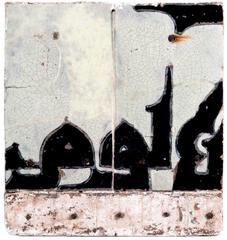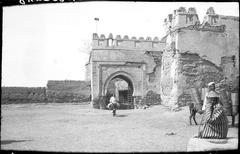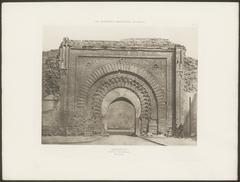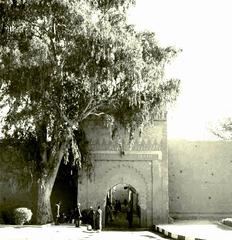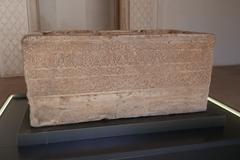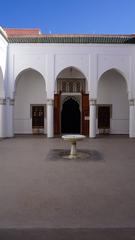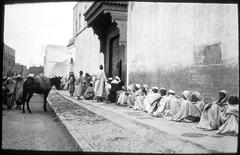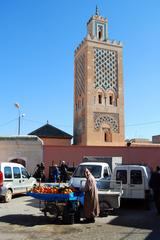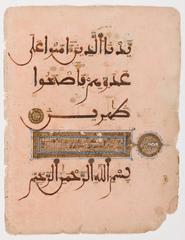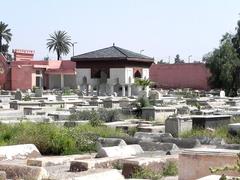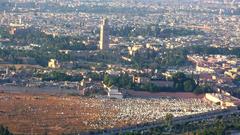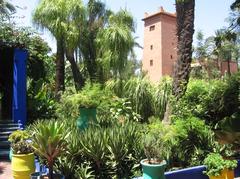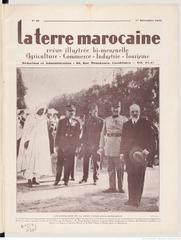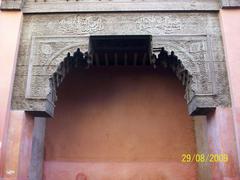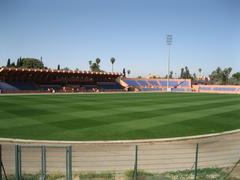
Oued Tensift Bridge Visiting Hours, Tickets, and Travel Guide – Marrakesh, Morocco
Date: 04/07/2025
Introduction: Oued Tensift Bridge – Marrakesh’s Medieval Gateway
Just north of Marrakesh’s vibrant heart, the Oued Tensift Bridge stands as a monumental testament to Morocco’s medieval engineering and enduring cultural legacy. Originally commissioned by the Almoravid emir Ali Ibn Yusuf in the early 12th century, the bridge was a vital infrastructure project, facilitating trade, military campaigns, and urban expansion by providing a reliable crossing over the unpredictable Tensift River (Wikipedia: Oued Tensift Bridge). After the original structure was destroyed by floods, the Almohad caliph Abu Yaqub Yusuf oversaw its resilient reconstruction in 1170 CE. The resulting 27-arch stone bridge is celebrated for its robust engineering and historical significance, linking Marrakesh to northern trade and military routes (Water Museums Network).
Today, the Oued Tensift Bridge remains a free, open-air site, welcoming visitors year-round. This guide provides all the essential information on visiting hours, accessibility, travel tips, and the bridge’s rich heritage, ensuring you make the most of your journey to one of Morocco’s most enduring landmarks (Medias24).
Table of Contents
- Early Origins and Strategic Importance
- Almohad Reconstruction and Architectural Features
- Regional Role in History and Trade
- Architectural Significance
- Visitor Information: Hours, Tickets, Accessibility
- Practical Travel Tips
- Nearby Attractions
- Preservation and Cultural Value
- Visual and Media Resources
- Frequently Asked Questions (FAQ)
- Summary and Final Thoughts
- References
Early Origins and Strategic Importance
The Oued Tensift Bridge’s history is tightly interwoven with Marrakesh’s rise as an imperial capital. The Tensift River, flowing from the High Atlas Mountains, has long posed a formidable barrier to trade and travel northward (Wikipedia: Oued Tensift Bridge; Wikipedia: Pont sur l’Oued Tensift). The Almoravid emir Ali Ibn Yusuf, renowned for his architectural patronage, commissioned the first bridge here in the early 12th century, engaging Andalusian architects to realize his vision. This bridge provided the only reliable crossing north of Marrakesh, connecting the city to trade routes leading to Salé, Rabat, and Casablanca (Wikipedia: Pont sur l’Oued Tensift).
However, the original structure succumbed to the river’s floods within a few years, illustrating the engineering challenges posed by the Tensift’s powerful seasonal currents (Le360).
Almohad Reconstruction and Architectural Features
In 1170 CE, under Almohad caliph Abu Yaqub Yusuf, a new bridge was constructed roughly 400 meters downstream of the original site, at a wider and less flood-prone section of the river (Wikipedia: Oued Tensift Bridge). This bridge initially featured 15 stone arches and was later expanded to 27 as the riverbed widened, making it the largest bridge on the Tensift (Water Museums Network).
Key architectural highlights include:
- Durable Stone Piers: Featuring a pointed, stepped profile upstream to deflect the river’s current, and a blunt profile downstream for stability.
- Semi-circular Arches: A hallmark of Islamic and Andalusian engineering (Global Morocco Exploration).
- Traditional Materials: Constructed primarily of local stone, with some brick and rammed earth, reflecting the craftsmanship and resourcefulness of Almohad builders.
Over time, the bridge has undergone restorations, most notably by the Saadian and Alaouite dynasties, ensuring its continued resilience (Wikipedia: Pont sur l’Oued Tensift).
Regional Role in History and Trade
For centuries, the Oued Tensift Bridge served as the only reliable northern crossing of the river, crucial for the movement of caravans, armies, and traders between Marrakesh and Morocco’s northern cities (Wikipedia: Pont sur l’Oued Tensift). Archaeological evidence reveals remnants of a sophisticated hydraulic system, including seguias (irrigation channels), siphons, and basins. In military history, the bridge played a strategic role, as seen during the Portuguese assault of 1515, when its partial destruction impeded troop movements (Wikipedia: Pont sur l’Oued Tensift).
The bridge’s historical significance is matched by its symbolic role as a connector—physically linking Marrakesh to the hinterlands and symbolizing the city’s openness to trade and cultural exchange (Medias24).
Architectural Significance
The Oued Tensift Bridge exemplifies Almohad civil engineering and the broader trends of Islamic North African architecture of the 12th and 13th centuries (Global Morocco Exploration). The use of arches, robust stonework, and practical yet elegant design solutions demonstrates the technical skill and aesthetic sensibility of its builders. The bridge is also integral to Marrakesh’s historic water management system, which underpinned the city’s prosperity (Water Museums Network).
Visitor Information: Hours, Tickets, and Accessibility
Visiting Hours:
Open 24 hours a day, seven days a week. For safety and optimal photography, visit during daylight (8:00 AM–sunset).
Tickets and Entry:
There are no entrance fees or tickets. The bridge is a public monument, free for all visitors.
Accessibility:
- Accessible on foot, by bicycle, or by vehicle.
- The stone surface can be uneven and slippery when wet; visitors with mobility concerns should take care.
- Parking is available nearby, and taxis can drop you close to the site.
How to Reach:
The bridge is located on the northern edge of Marrakesh, accessible via the main road toward the northern suburbs (wherestherooftop.com). Taxis and local buses offer convenient options. It’s approximately a 15-minute drive from the Medina.
Practical Travel Tips
- Best Time to Visit: October to April, when temperatures are mild. Early mornings and late afternoons offer the best light for photography.
- What to Bring: Water, sun protection, comfortable shoes, and a camera. There are no public restrooms or cafes at the site.
- Safety: The area is generally safe during the day. Beware of uneven surfaces and avoid isolated areas after dark (travelsafe-abroad.com; thebrokebackpacker.com).
- Guided Tours: Local guides are available for deeper historical and cultural insights (airbnb.com).
Nearby Attractions
- Agdal Gardens: UNESCO-listed royal gardens south of the bridge.
- Menara Gardens: Known for its pavilion and olive groves west of Marrakesh.
- Koutoubia Mosque: The largest mosque in Marrakesh, centrally located.
- Marrakesh Medina: The historic old city, ideal for exploring souks and museums.
Day trips can also combine visits to the Atlas Mountains, the Agafay Desert, or the Palmeraie district (wherestherooftop.com; agafaydesertluxurycamp.com).
Preservation and Cultural Value
Despite weathering floods, wars, and centuries of use, the Oued Tensift Bridge has been repeatedly restored to ensure its survival (Le360). Currently, a modern bridge nearby handles heavy traffic, reducing stress on the historic structure. Preservation efforts focus on maintaining the bridge’s integrity in the face of environmental pressures and urban development (Medias24).
Culturally, the bridge is a symbol of resilience and community. It is still used for local crossings and is a gathering place, especially during festivals and holidays. The site embodies the enduring connection between Marrakesh’s urban core and its rural surroundings.
Visual and Media Resources
- Photography: Panoramic shots at sunrise or sunset highlight the bridge’s arches and the Atlas Mountains backdrop.
- Aerial Views: Balloon flights over the valley offer unique perspectives (agafaydesertluxurycamp.com).
- Online Resources: Virtual tours and photo galleries are available on tourism websites and heritage platforms.
Frequently Asked Questions (FAQ)
Q: Is there an entrance fee?
A: No, the bridge is free to visit.
Q: What are the best visiting hours?
A: Daylight hours (8:00 AM–sunset) are safest and most scenic.
Q: Is the bridge accessible for those with limited mobility?
A: The surface is uneven; visitors with mobility challenges should use caution. Modern bridges nearby offer easier access.
Q: Are guided tours available?
A: Yes, local guides can be arranged for cultural and historical tours.
Q: Are there facilities nearby?
A: Facilities are limited at the bridge; amenities are available in nearby suburbs or the city center.
Summary and Final Thoughts
The Oued Tensift Bridge is more than a medieval structure—it is a living symbol of Marrakesh’s historical depth, architectural ingenuity, and vibrant cultural continuity. From its Almoravid origins through Almohad reconstruction and ongoing preservation, the bridge illustrates the dynamic interplay of environment, engineering, and society in Morocco’s past (World History Journal). Visitors today can enjoy free, all-day access, with the best experiences to be had during mild weather and daylight. Combine your visit with nearby historical and natural attractions for a comprehensive exploration of Marrakesh’s heritage (Medias24). For in-depth guidance and updates, download the Audiala app and connect with local experts to make the most of your journey.
References and Further Reading
- Wikipedia: Oued Tensift Bridge
- Wikipedia: Pont sur l’Oued Tensift
- Le360
- Water Museums Network
- Global Morocco Exploration
- Portail Sud Maroc
- Medias24
- World History Journal
- Where’s The Rooftop
- Agafay Desert Luxury Camp
- The Broke Backpacker
- Travel Safe Abroad
- Airbnb – Oued Tensift
- Happy to Wander
- Local Adventurer
- Lonely Planet
- Parametric Architecture

